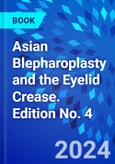- Revised throughout with updated case examples, select new patient photos, and updated coverage based on the recent literature.
- Eight new chapters, including Visual, Physiological and Aesthetic Factors Affecting Outcome in Asian Blepharoplasty; Techniques, Principles, and Benchmarks in Asian Blepharoplasty; Depth of Upper Lid Crease Construction in Asian Blepharoplasty; Ratios and Proportions in Double-Eyelid Segments; The Eyelid Crease Height, Depth, and Shape: A Scoring System for Revisional Asian Blepharoplasty; Failure Analysis in Asian Blepharoplasty; An Intraoperative Primer: Paths, Pitfalls, and Solutions in Asian Blepharoplasty (Incisional Methods), and A Deeper Interpretation of the Asian Blepharoplasty Technique of Trapezoidal Debulking and Clearance of Preaponeurotic Space.
- Contains a new paradigm of scoring suboptimal findings based on eyelid crease height, depth, and crease shape, providing realistic assessment and comparison.
- Step-by-step instructions for optimizing the biodynamics for eyelid crease formation; how to eliminate the prominent medial upper lid fold; removing tissues as a trapezoidal block using minimized steps; and much more.
- Expanded guidance on managing complications integrated throughout, with surgical pearls and summative boxes where relevant.
- High-quality, full-color artwork shows three-dimensional representations of key anatomy and procedural steps.
- Extensive collection of case studies, with before and after patient photos; plus practice worksheets, appendix tables, comprehensive references, and pearls and pitfalls throughout.
- Features a comprehensive video program including 18 primary surgery cases, 12 revisional surgery cases, 10 “short step” videos, 6 concept videos, and 22 edited compilations of video clips depicting how to approach each procedural step across a range of patient cases.
- An eBook version is included with purchase. The eBook allows you to access all of the text, figures and references, with the ability to search, customize your content, make notes and highlights, and have content read aloud.
Table of Contents
1 What is an Upper Lid Crease and Historical Consideration
2 Comparative Anatomy of the Eyelids
3 The Eyelid Crease: Consultation, Counseling, Goals and Expectations
4 Suture Ligation Methods
5 External Incision Methods
6 Asian Blepharoplasty I: The First Traverse (Vector)
7 Asian Blepharoplasty II: The Second Traverse (Vector)
8 Concept of Triangular, Trapezoidal and Rectangular Debulking: Application in Asian Blepharoplasty
9 Optimal Closure and Management of Wound Healing
10 Primary Asian Blepharoplasty Results (Before and After)
11 Suboptimal Factors
12 Revision Parameters
13 Revisions in Suboptimal Cases
14 Advanced Concept of a Glide Zone as it Relates to Upper Lid Crease, Lid Fold and Application in Asian Blepharoplasty
15 Wpd Chen's Technique Of Super-Beveled Approach and Mid-Lamellar Clearance in Revisional Asian Blepharoplasty
16 Angle of Observation, Crease Height, Tarsal Tilt and Its Effects on Planning for Upper Blepharoplasty
17 Investigation of Tarsal Tilt: its Effects on Normal and Abnormal Conditions and Clinical Outcome of Upper Blepharoplasty
18 Effect of High Anchoring of the Crease, Faden-Like Effect and Use of Buried Sutures
19 Visual, Physiological and Aesthetic Factors Affecting Outcome in Asian Blepharoplasty
20 Treatment of Medial Upper Lid Fold and the Fog Surrounding Epicanthoplasty
21 Advanced Concept of the Eyelid Crease as a Stringed Series of Unipoints
22 Techniques, Principles and Benchmarks in Asian Blepharoplasty
23 Summary of Eyelid Crease Factors
24 Depth of Upper Lid Crease Construction in Asian Blepharoplasty
25 Ratios and Proportions in Double-Eyelid Segments
26 The Eyelid Crease Height, Depth, and Shape: A Scoring System for Revisional Asian Blepharoplasty
27 Failure Analysis in Asian Blepharoplasty
28 An Intraoperative Primer: Paths, Pitfalls, and Solutions in Asian Blepharoplasty (Incisional Methods)
29 Outlook for Aesthetic Asian Eyelid Surgery
30 A Deeper InterpretationOF THE Asian Blepharoplasty Technique of Trapezoidal Debulking and Clearance of Preaponeurotic Space
Appendix 1 Pre-1952 Japanese Literature on Cosmetic Eyelid Surgery (in Japanese)
APPENDIX 2 Modern Literature on Asian Eyelid Surgery
APPENDIX 3 Recent Literature (1998-2021) on Asian Eyelid Surgery
APPENDIX 4 Recent Literature on Epicanthoplasty
APPENDIX 5 Aesthetic Effects of Asian Blepharoplasty
APPENDIX 6 Recent Literature on Anatomy
Index








